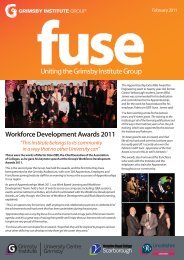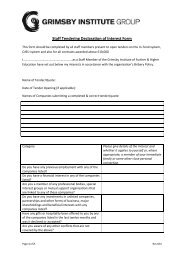Journal of Research & Scholarly Output 2006 - Grimsby Institute of ...
Journal of Research & Scholarly Output 2006 - Grimsby Institute of ...
Journal of Research & Scholarly Output 2006 - Grimsby Institute of ...
You also want an ePaper? Increase the reach of your titles
YUMPU automatically turns print PDFs into web optimized ePapers that Google loves.
1996). This legislation needs to be backed<br />
up by comprehensive guidance for<br />
organisations genuinely interested in<br />
involving the workforce in all aspects <strong>of</strong><br />
health and safety at work.<br />
Why a systems approach?<br />
Taking into account the previously<br />
discussed issues, there are many reasons<br />
why organisations may have difficulty in<br />
attempting to involve workers in health and<br />
safety. So how do organisations go about<br />
promoting WISH? Well, one point that is<br />
glaringly apparent is that compliance with<br />
statutory provisions alone will not engender<br />
the levels <strong>of</strong> involvement needed to bring<br />
about noticeable improvements in health<br />
and safety performance. If organisations<br />
are to truly reap the rewards <strong>of</strong> worker<br />
involvement then it requires managing in the<br />
same way as any other organisational<br />
function. Taking this assertion on board, the<br />
WISH Management Model has been<br />
proposed as an adaptation <strong>of</strong> the HSE’s<br />
familiar framework for successful health and<br />
safety management (HSE, 1997),<br />
advocating a systems approach to<br />
managing WISH.<br />
From the outset, a commitment to worker<br />
involvement should be clarified within a<br />
policy, ideally this should be distinct from<br />
the general safety policy. The WISH policy<br />
should include a management commitment<br />
to involving the workforce in all aspects <strong>of</strong><br />
health and safety, from the development <strong>of</strong><br />
the safely policy itself, to an ongoing<br />
involvement in risk assessments and the<br />
improvement <strong>of</strong> safe systems <strong>of</strong> work. The<br />
WISH policy is pivotal within the systems<br />
approach and once it is in place, attempts<br />
can then be made to organise the workforce<br />
for effective worker involvement. The<br />
organising stage will ensure that the<br />
workforce has the levels <strong>of</strong> competency<br />
needed to actively contribute to health and<br />
safety at work. It will also involve making<br />
sure that there are adequate mechanisms in<br />
place for communicating information on<br />
worker involvement. These organisational<br />
requirements will be supported by effective<br />
co-operation between all parties and control<br />
over worker involvement practices. Once<br />
the 4 Cs’ <strong>of</strong> worker involvement are in place,<br />
the organisation will be on the right lines to<br />
fostering a safety culture founded upon<br />
worker involvement.<br />
At the planning and implementation stage,<br />
organisations need to identify where they<br />
are in terms <strong>of</strong> worker involvement before<br />
looking at the mechanisms needed to<br />
promote greater involvement. It must be<br />
appreciated that there is a clear spectrum <strong>of</strong><br />
worker involvement, with the provision <strong>of</strong><br />
information perceived as a very loose form<br />
<strong>of</strong> worker involvement, right up to the polar<br />
extremes <strong>of</strong> co-determination (Works<br />
Councils) and self-management.<br />
Consultation and participation are both<br />
presented as forms <strong>of</strong> worker involvement<br />
within the worker involvement spectrum,<br />
with participation argued as a purer form,<br />
permitting the active involvement <strong>of</strong><br />
employees at management decision making<br />
level.<br />
The mechanisms for involving the workforce<br />
are wide and varied, however, what is more<br />
important is that organisations look into<br />
finding the balance <strong>of</strong> mechanisms that<br />
‘best fits’ their organisation.<br />
Page 42<br />
FOCUS

















